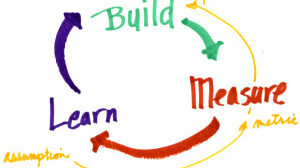I spent the first half of my week at the Society for Healthcare Strategy and Market Development (SHSMD) conference in Washington, D.C. While I am so accustomed to hearing case studies about “getting it right” at these conferences, I was intrigued by a subtle theme of why it sometimes is even better to fail – as long as you learn from it. Taking risks is a challenge, especially in a traditional industry like healthcare, where failing (at least, on the clinical side) can mean life or death. It’s also highly-regulated, which makes communicators especially wary of exploring unchartered waters.
As with most industry conferences, we had several speakers from outside of healthcare, who helped to broaden our thinking. It was Eric Ries, author of the book The Lean Startup: How Today’s Entrepreneurs Use Continuous Innovation to Create Radically Successful Businesses, who resonated with me along this theme of learning from low-risk failures.
Ries’ book, published in 2011, was originally focused on start-up companies and how they can shorten their product development cycles through “adopting a combination of business-hypothesis-driven experimentation, iterative product releases, and validated learning.” According to Ries, failure can be productive and a 10% success rate is pretty good. He’s trained GE executives on the approach, helping to create an approach called “FastWorks,” helping to deliver better outcomes to customers, faster.
How could that ever relate to what we do in healthcare communications?
In a world that is being driven by digital communications (hello, look at you reading this blog post), we have an opportunity to test approaches and messages and “pivot,” as Ries suggests, rapidly and without significant consequence. In doing so, we are able to fine tune our campaigns and execute “precision marketing” (efficiency in reaching target markets with a relevant message), as the speakers in Penn Medicine’s “The Marketing Laboratory: Achieving Marketing Success through Experimentation, Iteration, and Insight” session noted. In their session, Sarah Sanders, Associate Chief Marketing Officer at Penn Medicine, and Tanya Andreadis, Director, Digital Strategy at Penn Medicine, presented an overview of their hypothesis-driven marketing experiment. With more than 100 digital campaigns over the course of four years, they were able to use their learnings from testing a variety of hypotheses to optimize campaigns over time. The results included a 25% increase in total volume and a 33% increase in appointment requests – and more than 20,000 digital leads.
As communicators, we love research, but it can be cost and time-prohibitive. With digital campaigns, such as Facebook advertising, or native advertising, we have the opportunity to quickly evaluate whether or not our message is resonating, and change our course.
This isn’t to say that we shouldn’t invest in large campaigns across mediums such as print, where it is more difficult to test and make changes mid-campaign. Rather, we should consider testing our message using digital platforms before we make that investment.
At the end of his session, Ries challenged our SHSMD cohort to find a buddy, identify a hypothesis that we planned to test, and report back this upcoming Monday. What hypothesis are you planning to test? Have you seen surprising results? We’d love to know!

